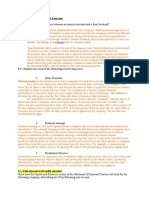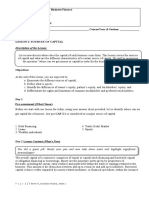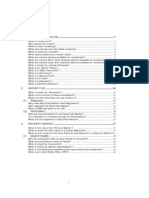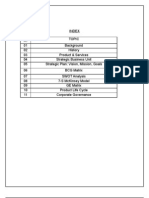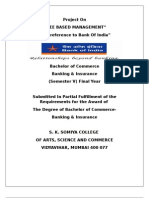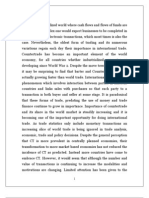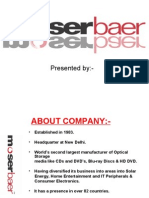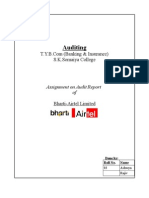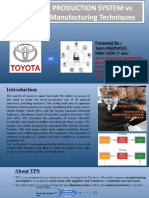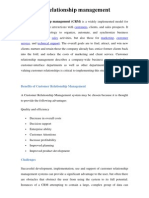Capital Increase What Is A Capital Increase?
Capital Increase What Is A Capital Increase?
Uploaded by
vahidCopyright:
Available Formats
Capital Increase What Is A Capital Increase?
Capital Increase What Is A Capital Increase?
Uploaded by
vahidOriginal Title
Copyright
Available Formats
Share this document
Did you find this document useful?
Is this content inappropriate?
Copyright:
Available Formats
Capital Increase What Is A Capital Increase?
Capital Increase What Is A Capital Increase?
Uploaded by
vahidCopyright:
Available Formats
We have written this guide in order to help you acquire knowledge on various questions regarding the Corporate Actions
that occur on financial markets. In this guide, you will find all necessary information that you may require on the decisions that a company can take regarding the structure of its capital, such as a capital increase, a capital reduction, a split, a spin off, mergers and acquisitions, an IPO, etc.. All these notions will be explained to you in a very concise and comprehensible way. Our Corporate Actions Topics: 1. Capital Increase 2. Split 3. Reverse Split 4. Spin-off 5. Mergers & Acquisitions (M&A) 6. IPO (Initial Public Offering) 7. Capital Reduction 8. Dividend 9. Delisting 10. Change of security class ^ Capital Increase What is a capital increase? A capital increase is the increase of a companys equity capital through the issue of additional share capital. It is therefore an external (or participatory) means of financing. How is a capital increase achieved? Technically, a capital increase consists of an increase in the number of shares and therefore in the companys share capital. The issuing company can place these new shares with its existing shareholders or with new shareholders. There are three fundamental types of capital increases: 1. Capital increases with rights issue: To avoid capital dilution, existing shareholders are given a pre-emptive right to subscribe the shares that are being newly issued. This is achieved by issuing subscription rights. Specific laws require the issue of subscription rights. A subscription right is a current shareholders right to acquire new shares at a specific ratio to his holding in old shares. However, a companys Shareholders General Meeting may decide to waive subscription rights on issuing new shares. The value of a subscription right is calculated as follows: Market price of the old share price of the new share __________________________________________ Subscription ratio + 1 As the subscription rights value depends on the old shares market price, the calculated value will fluctuate with the market.
Subscription right R =
Normally, subscription rights are officially listed and traded on the exchange, thus enabling shareholders to decide whether they wish to acquire new shares or sell their rights. If, for example, a company is subject to US tax law, there is a tax advantage in not listing subscription rights. If, in that case, a shareholder waives his right to purchase the newly issued shares, his subscription right loses all its value. 2. Capital increase without subscription rights In Switzerland, these forms of capital increase require shareholder approval, so they rarely occur. In such cases, new shares can be subscribed directly, as for example in the case of an IPO, when a company deliberately seeks to widen its shareholder base.
Swiss Code of Obligations, art. 652b par. 2 provides that when making a decision to increase corporate share capital, the Shareholders General Meeting may only decide to waive subscription rights for important reasons. In particular, such reasons include the acquisition of another company, a part of or a holding in another company, as well as employee participation in the companys capital. The waiver of subscription rights may not wrongfully favour or discriminate against any individual. 3. Capital increase through the distribution of free shares: A company may decide to let shareholders participate in its earnings through the distribution of free or bonus shares, the advantage being that the companys cash balance will not be affected in the process. Its equity capital remains unchanged, while the profit or reserve items in the balance sheet will be reduced and the share capital increased. A shareholder must pay income and withholding tax on the acquisition of bonus shares. Why do companies seek to increase their share capital? Increasing the share capital and, thereby, the equity capital, has various advantages: - No interest is payable on the capital, so that the companys cash need not be used to service a corresponding debt. - As opposed to debt capital, share capital need not be repaid and remains at the companys disposal for an unlimited length of time. A company resorts to a capital increase when it has long-term capital requirements and market conditions for capital borrowings (loans or bond issues) are unfavourable. Example of a capital increase accompanied by a listing of subscription rights Official Notice of the SWX Swiss Exchange On 6 June 2000, the Ordinary General Meeting of the shareholders of Industrieholding Cham AG has decided, at the recommendation of the Board of Directors, to increase the companys share capital by CHF 40320000 to CHF 80640000 through the issue of 403200 registered shares with a par value of CHF 100. The companys bank syndicate has tendered the new shares and, pursuant to a subscription right, will offer them for subscription to current shareholders on
the following conditions:
Subscription period 14 June until 21 June 2000, noon Subscription ratio 1 current registered share with a par value of CHF 100 entitles the holder to 1 new registered share with a par value of CHF 100. Subscription price CHF 150.- for each new share with a par value of CHF 100. The federal stamp duty of 1% on new issues is paid by the company. Listing of subscription rights 14 June until 20 June 2000 on the SWX Swiss Exchange (Official security code 1082325 / ISIN CH 001 082 325 7) Exercise of the subscription right The rights may be exercised on presentation of the subscription right certificates attached to current registered shares, through use of the form Subscription Certificate and Registration Request. Physical holders of registered shares will receive the subscription right certificates directly from the companys registrar, whereas all other subscription right certificates will be sent to the appropriate depository banks. Holders of registered shares stored at their homes or in a bank safe are kindly requested to present the subscription right certificates attached to current registered shares for use with the form Subscription Certificate and Registration Request for subscription at an official subscription office or via their banks. Sales restrictions General sales restrictions; USA/US persons, United Kingdom
Split What is a split and how is it achieved?
A share split consists in the increase of the number of shares in issue, combined with a proportionate reduction in the shares par value. The share capital thus remains unchanged. A holder of 100 registered shares with a par value of CHF 1000 per share will become, after a 1:10 split of the stock, holder of 1000 shares with a par value of CHF 100. What is the aim of a share split? The market value of a share may increase substantially over time. It is therefore possible that a share with a par value of CHF 100 reaches a market price of CHF 10000. Such a share is called heavy. For many investors, its high market price represents an obstacle to investment, as for CHF 10000, several different lighter shares may be bought, thus ensuring an improved risk distribution. As a result, trading in heavy shares becomes less liquid and restricted to a relatively small number of investors. A share split enables a company to counter this trend. Example of a share split In the summer of 2000, UBS AG split its stock by a 2:1 ratio, even though, at a market
price of about CHF 450, UBS shares were not particularly heavy. The trend is clearly towards increasing share negotiability. Furthermore, Switzerland is likely to reduce the current minimum legal par-value of CHF 10 in the near future. Reverse Split What is a reverse split and how is it done? A reverse split consists of an increase in a shares par value, combined with a proportionate reduction in the number of shares outstanding. What is the purpose of a reverse split? A security can not only be too heavy, but also too light. A low market value is not necessarily favourable to a shares negotiability. Example of a reverse split In the summer of 2000, TEGE SA decided to have a reverse split performed on its shares. In the process, the share capital was first reduced from CHF 31060000 to CHF 3106000, by means of a reduction of the stocks par value from CHF 10.- to CHF 1.per share. Then, the bearer shares with a par value of CHF 1.- were merged into bearer shares with a par value of CHF 10.- by exchanging 10 shares at CHF 1.- against one new share at CHF 10.- par value. ^
Spin-off What is a spin-off?
A spin-off is a holding companys divestment of a subsidiary or a companys divestment of a division or business segment. The divested entity can then be independently listed on the exchange. How does a company spin off a subsidiary? Technically, it is relatively simple for a holding company to divest itself of a subsidiary: the subsidiarys value is assessed by the holding with the help of financial analysts. This amount should correspond to the market value of the newly listed entity and be deduced from the parent entitys value after the spin-off. If a corporation with a market value of CHF 1bn spins off a subsidiary that has been valued at CHF 100m, the parent company should be valued at CHF 900m by the market and the former subsidiary at CHF 100m after the spin-off. This will only occur, however, if investors fully share the views of the analysts who calculated the subsidiarys theoretical value. If a company has decided to spin-off one of its divisions or business units, the divested entity must be restructured in such a way as to enable the creation of a legally independent company. Otherwise, the spin-off process is the same as described above.
What is the aim of a spin-off? - To separate a subsidiary completely from its parent company, i.e. to give it economic and legal independence. This may be done, for example, if the subsidiary no longer fits the parents strategic aims or if it is no longer considered of sufficient economic interest. - To effect a capital increase for a specific division/subsidiary of a corporation. This process may run in parallel with an IPO. Thus, for example, a capital increase is part of the regulatory requirements of an IPO on the SWX New Market. - To allow a controlling company to divest itself partially of a subsidiary and merge it with another company. This could for example be a sensible approach if two subsidiaries of two different companies operate in the same business segment. To create synergies, the two companies merge their activities, yet the merger is restricted to the business segment in question. - A division/subsidiary is to remain as part of the controlling holding company, yet traded separately on the exchange. The aim here is to create shareholder value and to allow investors to value different business segments at different levels. For the holdings management, the task is also simplified by the fact that less attention needs to be given other business segments. A spin-off can be seen as an extreme profit or cost centre. Example of a spin-off On 9 May 2000, the Shareholders General Meeting of F. Hoffmann - La Roche approved the spin-off of Givaudan Roure, the worlds leading manufacturer of flavours and fragrances. On 8 June 2000, the shares of the newly created Givaudan SA were traded for the first time on the SWX Swiss Exchange. The share price (CHF 10 par value) was valued at CHF 545 on 7 June. In total, Givaudans capital structure is made up of 8'625627 shares. Thus, the market value of Givaudan was estimated at approximately CHF 4.7bn. Accordingly, the value of a Roche bonus certificate or bearer share was reduced by CHF 545. On its first day of listing, Givaudans stock closed at CHF 510, i.e. below the theoretical reference price of CHF 545.
Mergers & Acquisitions (M&A) What are mergers & acquisitions? Mergers and acquisitions (M&A) designate a very close form of corporate alliance, namely a full merger. It is not always easy to distinguish a merger from an acquisition. The technical difference is the following:
- In the case of an acquisition, one of the merging companies (A) plays a dominant role and acquires the other (B). An enlarged company A is created as a result. The take-over may take place with or without the consent of Bs management. The latter action is
called a hostile take-over. The acquisition may be paid for in cash or by means of the acquiring entitys own shares. - In the case of a merger, two (or more) companies (in this case, A and B) decide to merge into a new company (C), whereby the new entity is fully made up of the two existing companies. Technically, there are two ways to achieve this: 1. The new company is a holding company, which retains the existing companies (and their names) as subsidiaries, thus ensuring them a certain degree of independence. 2. The new company represents a complete merger of the previous entities, in which even their names are changed (e.g. UBS and SBC). Sometimes, under closer scrutiny, mergers turn out to be acquisitions in disguise. This is the case when one of the merging partners is dominant and accordingly assumes a more powerful position in the newly founded company. A merger results in the complete integration of the companies balance sheets. Therefore, the valuation of each company prior to the merger is of the highest importance, as it will determine the distribution ratio of the new entitys stock among the shareholders of the pre-merger companies. How are mergers and acquisitions achieved? Acquisitions are easier to achieve than mergers. Suppose a company (A) decides to take over another company (B). To do so, A must be ready to pay a price corresponding to Bs market value. Whether the payment is made in cash or shares is of minor importance technically. As shareholders retain their shareholder status and may decide whether the acquisition of B is appropriate or not. If a shareholder disapproves of the take-over, he can sell his holdings in A. Currently, the share prices of acquired companies tend to rise, whereas those of the acquirers tend to fall on the news of a take-over. Mergers are highly complex transactions involving not only the mere integration of two companies, but also the decision of two theoretically equal-sized partners, which are often radically different, to operate as a single entity. Therefore, both companies must agree on their respective theoretical values. On that basis, shares in the new company will be distributed among both companies shareholders in proportion to their respective valuations. According to recent surveys, 50% of mergers are not successful. The positions of more than half of all merged companies are therefore at least no more enviable than before their mergers. The number of announced mergers that eventually fail is also rising. This can be due, for example, to the fact that the corporate cultures of two merger partners are more different than management teams had initially expected. A perfect example is the Merger between Daimler and Chrysler. Why are mergers and acquisitions performed? The exploitation of synergy is a popular reason for M&A activity. Synergy may be defined in different ways: - Horizontal mergers:
The companies involved operate in the same business segment and aim to reduce their fixed and marginal costs by merging their activities. This expectation is supported by the view that corporations can only achieve economies of scale if they exceed a certain critical mass. - Vertical mergers: The companies involved have neighbouring links in the value-added chain. Such alliances can reduce general overheads. Often, vertical mergers also enable the participants to ensure that corporate secrets are not leaked to third parties. Finally, providers of finished product components increasingly tend to be integrated in the manufacturing process. - Conglomerate mergers (diversified companies): The companies involved operate in sectors that are not even remotely related. This corresponds to the structure of a holding company aiming to diversify its risk exposure through a diversified portfolio of activities. In this case, the merged or acquired companies normally remain largely independent, with only certain specific functions, such as IT or human resources, being managed centrally. The holding company mainly deals with strategy and hardly gets involved in the different companies operating activities. IPO (Initial Public Offering) What is an IPO? Through an IPO, a privately owned stock company becomes a publicly listed company. Its shares (or at least part of them) are made accessible to the public and to institutional investors and listed on a securities exchange. Shares are therefore issued, which may be subscribed and subsequently traded on the exchange. How does an IPO take place? An IPO is a lengthy process. Stock exchanges have stringent listing requirements, which must be met by a company before its shares are listed. In an IPO, the share placement either applies to the existing shares held by current shareholders or to new shares created by means of a capital increase. The placement is achieved by a bank syndicate, which acquires the shares before offering them for subscription. The syndicate and the company negotiate a price range within which the shares may be placed. Normally, the subscription (or bookbuilding) period lasts one to two weeks, and normally ends shortly before the shares are listed on the exchange. At the end of the bookbuilding period, the final subscription price is fixed (once again through negotiation between the banks and the company). Therefore, an investor subscribing newly issued shares will only be informed subsequently of the price to pay. Shares attributed to investors can then be freely traded on the exchange. The bank syndicate has a socalled greenshoe option, which is an option to increase the number of distributed shares if demand for the now listed shares is particularly strong. In general, company employees are offered the opportunity to subscribe shares on advantageous terms, but are restricted from selling stock during a specified length of time, called the lock-up period. Why do companies launch IPOs? ^
Companies may launch an IPO for different reasons: 1. Payment to shareholders: In a family-owned joint stock company, there may be family members who desire to have their share capital paid out to them. This happens in particular in large, well established companies. The listing of Tamedia in October 2000 is a good example. 23% of the shares held by the Coninx family were publicly placed during the IPO, which yielded no capital to the company itself. 2. Privatisation of state-owned companies: When a state-owned organisation plans to go public, it first needs to be converted into a stock company in which the state becomes the sole shareholder. Then, by means of an IPO, part of the shares may be placed among the public. The state thus benefits from a fresh inflow of cash without immediately being forced to relinquish its majority stake in the company, and therefore retains overall control of it. The flotation of the Swiss telecommunications company, Swisscom, is an example of privatisation. Swisscom was first listed on SWX on 5 October 1998. On that date, 30% of the companys stock was placed, and the remaining 70% remained in the hands of the Swiss Confederation. Meanwhile, the latter has exercised an option to sell an additional stake of 4.5%. 3. Expansion of smaller companies: In the summer of 1999, the SWX Swiss Exchange introduced a new segment called SWX New Market. According to the Additional Regulations covering the listing of securities on the SWX New Market, this segment has the following function: The SWX Swiss Exchanges SWX New Market segment is intended for the listing of companies that distinguish themselves by exploiting new distribution markets, by the use of innovative processes or by the development of new products or services. In particular, it is intended to facilitate the access of young companies to the exchange. IPOs on the New Market must be performed in connection with a capital increase. The Swissquote Group launched its IPO on the SWX New Market on 29 May 2000. In the process, 410000 shares were placed, of which 270000 were issued in a capital increase and 140000 came from previous shareholders.
An additional advantage of publicly listed companies is that they can create employee incentive plans in which staff receive stock-options. On the other hand, a companys listing requirements include rigorous accounting rules and the duty to report any price-sensitive information to the market. In addition, a publicly listed company may become the target of a hostile take-over bid.
Capital Reduction
What is share capital reduction? The capital reduction process means that a companys share capital and equity capital are reduced. In practice, this corresponds to a de-financing operation. How is capital reduction done? There are two basic ways of reducing capital: - By reducing the par value of the companys shares - By destroying shares. In this case, the company destroys shares it holds as owner. Normally, this process is preceded by a stock buy-back in which shareholders are invited to tender stock. Shareholders must approve any capital reduction in which the reduced capital is not wholly replaced by new, fully payable capital (Swiss Code of Obligations, art. 732.1). Why do companies reduce their capital? A company may decide to reduce its capital when it has excess liquidity and an insufficient return on equity. By repurchasing its own shares, the company automatically reduces its cash balance. The subsequent destruction of shares (the actual capital reduction) then reduces its equity capital, so that the return on equity increases even though earnings remain unchanged. This results in higher per-share earnings. Nevertheless, market reactions to capital reductions are not always positive. If a company pays cash back to its shareholders because of excess liquid assets, it also means that its management believes that further investment expenditure is no longer justified in that market. Example of capital reduction In the spring of 2000, Royal Philips Electronics announced a capital reduction. The groups share capital was reduced by 3%, and EUR 1.7bn was paid out to shareholders in the process. Philips paid EUR 1.26 per share and each block of 100 shares was replaced by 97 shares.
Dividend What are dividends?
According to the Swiss Code of Obligations, art. 660 par. 2, every shareholder is entitled to a proportionate share in book profits if the latter are, by law or pursuant to companys articles of association, meant for distribution among shareholders. This per-share participation in profits is called a dividend. According to the Swiss Code of Obligations, art. 698, the Shareholders General Meeting decides on earnings attributions and in particular on the dividend amount. The dividend amount may only be fixed after earnings attributions to legal and statutory
reserves have been deducted (Swiss Code of Obligations, art. 674). Dividends may only be paid out of the companys book profit and from reserves specially created for that purpose (Swiss Code of Obligations, art. 675). How are dividends paid? There are many ways for a listed company to establish its dividend policy. The most common dividend form in Switzerland is a fixed cash dividend. However, the US practice of earnings-adjusted dividends is slowly gaining ground. Dividends may also be paid in form of bonus shares or in kind, although such is rarely the case. When investors can choose between several dividend types, this is called an optional dividend. Why are dividends paid? Dividends are not only paid because the law requires it. Shareholders are entitled to share in the companys profits. However, the importance of dividends has diminished, as they now tend to be dwarfed by stock performance expectations. Examples of dividend payments In its 1999 Annual Report, SAirGroup wrote the following: For the 1999 financial year, the Board of Directors will ask the Shareholders Meeting of 27 April 2000 to approve the following: ... Dividend on dividend-entitled share capital of CHF 877420'905 (12'280'620 shares at CHF 4.00) = CHF 49'122480 ... If the Shareholders Meeting approves the Boards proposal, the dividend will be credited to registered shareholders or their depository banks as of 3 May 2000. In this example, the role of the Shareholders Meeting is to approve rather than determine the dividend amount. By paying a dividend of CHF 4.00 per registered share, SAirGroup transferred the neartotality of its annual profit (CHF 51230'044) to shareholders.
Delisting What is a delisting? A security is delisted when exchange trading has been suspended and there are no plans to subsequently resume trading in it. The security is deleted from the exchanges instruments database. How is delisting achieved?
In principle, it is the issuer who decides to delist a security. This decision must be justified in an official delisting request. The final date of trading is then set by the exchanges admissions board, which, in so doing, takes into account the imperatives of investor protection, orderly trading and the interests of the issuer requesting the delisting. The actual delisting announcement must be made at least three months prior to the securitys last trading day, in form of a written media announcement. If more than 5% of outstanding securities are still in public hands at the time of delisting, offexchange trading must be guaranteed for up to six months. If the delisting is the result of a merger or a liquidation, the time span between the delisting announcement and the last trading day may be shortened to five business days. Delisting can also be decided by the admissions board, for reasons detailed in the next paragraph. Why do companies delist? As already mentioned, delisting often results from a mergers or acquisition. Clearly, after the merger of two companies, only one share listing is required. A delisting caused by the liquidation of a company is far more unpleasant for its shareholders. If there is no longer sufficient liquidity to ensure appropriate trading in a security, the admissions board can cancel the securitys listing. The same decision can be reached if a security no longer meets the listing requirements. For example, if an issuers fails to meet information requirements that may, in extreme cases, lead to delisting of the security concerned. Example of delisting On 13 September 2000, Chase Manhattan Corporation and J.P. Morgan & Co. Incorporated announced their intention to merge. In the process, the shares of J.P. Morgan & Co. Incorporated were to be exchanged for The Chase Manhattan Corporation shares at a ratio of 1:3.7. The Chase Manhattan Corporation shares resulting from the exchange are traded on the New York Stock Exchange (NYSE). J.P. Morgan & Co. Incorporated therefore decided to have its ordinary shares delisted from the SWX Swiss Exchange. The suspension of trading in Switzerland was requested and granted for 3 January 2001 (last trading day: 29 December 2000) (SWX Official Notice). As this delisting was the result of a merger, the company did not have to comply with the three-month period between the official delisting announcement and the last trading day for the shares. In this example, the period was reduced to nine days.
Change of security class What is a change of security class? A change of security type is a change in the structure and category of a companys equity securities.
How are security-class changes achieved? A company may decide to merge its bearer and registered shares into a capital structure of registered shares only. In that case, the companys bearer shares must be converted into registered stock at a ratio dictated by the difference in par values. After the conversion, the bearer shares are delisted. In principle, the depository bank handles the exchanges administrative process, and no intervention is required from shareholders. Why change security classes? Companies increasingly tend to switch to a single-share structure and mostly list registered shares only. The advantage of the latter is that companies are informed of the identities of their shareholders, which notably facilitates, among others, the task of corporate communications. Example of a change in security class At its extraordinary general meeting of 15 September 2000, Ascom Holding AG decided to simplify its capital structure to include registered shares only. To this effect, Ascom bearer shares were first split to match the par value of registered shares, then exchanged, at a ratio of 1:1, for registered shares. A rights issue is a way in which a company can sell new shares in order to raise capital. Shares are offered to existing shareholders in proportion to their current shareholding, respecting their pre-emption rights. The price at which the shares are offered is usually at a discount to the current share price, which gives investors an incentive to buy the new shares if they do not, the value of their holding is diluted. A rights issue by a highly geared company intended to strengthen its balance sheet is often a bad sign. Profits are already low (or negative) and future profits are diluted. Unless the underlying business is improved, changing its capital structure achieves little. A rights issue to fund expansion can usually be regarded somewhat more optimistically, although, as with acquisitions, shareholders should be suspicious because management may be empire-building at their expense (the usual agency problem with expansion). The rights are normally a tradeable security themselves (a type of short dated warrant). This allows shareholders who do not wish to purchase new shares to sell the rights to someone who does. Whoever holds a right can choose to buy a new share (exercise the right) by a certain date at a set price. Some shareholders may choose to buy all the rights they are offered in the rights issue. This maintains their proportionate ownership in the expanded company, so that an x% stake before the rights issue remains an x% stake after it. Others may choose to sell their rights, diluting their stake and reducing the value of their holding. If rights are not taken up the company may (and in practice does) sell them on behalf of the rights holder.
It is possible to sell some rights and exercise the remainder. One possibility is selling enough rights to cover the cost of exercising those that are not sold. This allows a shareholder to maintain the value of a holding without further expense (apart from dealing costs). This does not mean that a shareholder can entirely neutralise the effect of a rights issue, only the element described by the formula below. As with a scrip issue, the price before the rights are issued needs to be adjusted for the rights issue. The calculation is a little more complicated as the new shares are paid for. Before comparison with share prices after the rights issue, prices before the shares went ex-rights need to be multiplied by:
((m y) + (n x) ) (m (x + y))
where x is the number of new shares issued for every y existing shares m is the closing price on the last day the shares traded cum-rights and n is the price of the new shares The same adjustment needs to be made to per share numbers such as EPS if they are to remain comparable, for example, when looking looking at growth trends. However, a large rights issue is often associated with other changes that will distort these numbers or change trends such as paying off debt, expansion, etc. This calculation makes the assumption that all rights will be exercised. This is usually an acceptable assumption as it is usual for a rights issue to be priced at a steep discount to the share price to ensure that the rights will be exercised. In the interval between the shares going ex-rights and the rights being exercised, if the share price falls low enough for the rights to have significant option value, then an adjustment may have to be made for this. This happens very rarely.
You might also like
- Maersk Line: B2B Social MediaDocument4 pagesMaersk Line: B2B Social MediaGarvita100% (1)
- Viper Drones Business PlanDocument21 pagesViper Drones Business Plannoel gonsalves100% (3)
- Tactical Financing DecisionsDocument24 pagesTactical Financing DecisionsAccounting TeamNo ratings yet
- Intermediate Accounting 2: a QuickStudy Digital Reference GuideFrom EverandIntermediate Accounting 2: a QuickStudy Digital Reference GuideNo ratings yet
- Famba 8e - SM - Mod 08 - 040920 1Document41 pagesFamba 8e - SM - Mod 08 - 040920 1Shady Mohsen MikhealNo ratings yet
- AS 9706 Theory FINALDocument11 pagesAS 9706 Theory FINALNew Id0% (1)
- Topic 5 - Sukokokopplemental Tasks and Exercises (Week 17)Document2 pagesTopic 5 - Sukokokopplemental Tasks and Exercises (Week 17)Taylor Kongitti PraditNo ratings yet
- Longterm InvestmentDocument36 pagesLongterm InvestmentKale MessayNo ratings yet
- Corporate Restructuring and Strategic AlliancesDocument5 pagesCorporate Restructuring and Strategic AlliancesAmit Kumar RathNo ratings yet
- Corporate ActionsDocument50 pagesCorporate ActionsJaiganesh Dakshinamurthy100% (4)
- Bonus SharesDocument12 pagesBonus SharesMohit SharmaNo ratings yet
- Financial Statement Analysis Professor Julian YeoDocument31 pagesFinancial Statement Analysis Professor Julian YeoHE HUNo ratings yet
- Module 8 - Shareholders' Equity, Retained Earnings, and DividendsDocument10 pagesModule 8 - Shareholders' Equity, Retained Earnings, and DividendsLaurio, Genebabe TagubarasNo ratings yet
- Shareholders EquityDocument30 pagesShareholders EquityEmmanuelNo ratings yet
- Corporate ActionsDocument10 pagesCorporate Actionsdhanraj patadiaNo ratings yet
- Earning Per ShareDocument22 pagesEarning Per Sharekimuli FreddieNo ratings yet
- Eps Ias 33Document5 pagesEps Ias 33Yasir Iftikhar AbbasiNo ratings yet
- Dividend Policy-Lecture and ExercisesDocument6 pagesDividend Policy-Lecture and ExercisesRica RegorisNo ratings yet
- All About StocksDocument21 pagesAll About Stockssimranjyotsuri7646No ratings yet
- Free Cash Flow (Solution)Document11 pagesFree Cash Flow (Solution)alliahnahNo ratings yet
- Blaine Kitchenware Inc PDFDocument13 pagesBlaine Kitchenware Inc PDFpatriciolivares3009No ratings yet
- How To Evaluate A StockDocument2 pagesHow To Evaluate A StockdarshanabmsNo ratings yet
- Unit 6: Long-Term InvestmentsDocument40 pagesUnit 6: Long-Term Investmentssamuel kebedeNo ratings yet
- Biglari 2010 LetterDocument10 pagesBiglari 2010 Lettereric695No ratings yet
- Accounting For Investments in SubsidiariesDocument63 pagesAccounting For Investments in SubsidiariesSoledad Perez100% (2)
- Corporate Action Final DhirajDocument32 pagesCorporate Action Final Dhirajmishradhiraj533_gmaiNo ratings yet
- Ruyembe JRDocument5 pagesRuyembe JRmwasitimagileNo ratings yet
- BUSINESS FINANCE Week 2Document7 pagesBUSINESS FINANCE Week 2Ace San GabrielNo ratings yet
- 03 Share Split and Treasury SharesDocument17 pages03 Share Split and Treasury SharesAlloysius ParilNo ratings yet
- Comment Type QuestionsDocument38 pagesComment Type QuestionsgoforcsNo ratings yet
- Int QuestionsDocument7 pagesInt QuestionsPraveen MalineniNo ratings yet
- Sources of FinanceDocument22 pagesSources of FinanceAkshay S PulimootilNo ratings yet
- PPT 7 Corporation - Share Transaction, Dividend, and Retained EarningDocument62 pagesPPT 7 Corporation - Share Transaction, Dividend, and Retained EarningAnatasya AlexandriaNo ratings yet
- CH 07Document23 pagesCH 07mehdiNo ratings yet
- Authorization For Issuance of Stock RightsDocument6 pagesAuthorization For Issuance of Stock Rightsaccounting probNo ratings yet
- AS20Document10 pagesAS20Selvi balanNo ratings yet
- Dividend Policy - 072 - MBS - 1st - Year PDFDocument5 pagesDividend Policy - 072 - MBS - 1st - Year PDFRasna ShakyaNo ratings yet
- Buy BackDocument15 pagesBuy BackRishi BajajNo ratings yet
- Basic Information On The Types of Limited Liability Companies and On The Rights of ShareholdersDocument20 pagesBasic Information On The Types of Limited Liability Companies and On The Rights of ShareholdersmoisespolancoNo ratings yet
- Beams Aa13e SM 08Document36 pagesBeams Aa13e SM 08Akila Kirana RatriNo ratings yet
- Dividends: 1.1 Definition of DividendDocument11 pagesDividends: 1.1 Definition of Dividendshiza sheikhNo ratings yet
- Dividends: 1.1 Definition of DividendDocument11 pagesDividends: 1.1 Definition of Dividendshiza sheikhNo ratings yet
- Corporate ActionsDocument4 pagesCorporate Actionscnvb alskNo ratings yet
- 2 CAPITALISATION MCom-I SemDocument6 pages2 CAPITALISATION MCom-I SemAkash PatilNo ratings yet
- Treasury SharesDocument9 pagesTreasury SharesKathleenNo ratings yet
- #17 Dividends and Stock RightsDocument4 pages#17 Dividends and Stock RightsZaaavnn VannnnnNo ratings yet
- Beams - AdvAcc11 - Chapter 8Document32 pagesBeams - AdvAcc11 - Chapter 8DiditNo ratings yet
- Essay On Capitalisation - Geetanjali Gems CaseDocument14 pagesEssay On Capitalisation - Geetanjali Gems CaseAnkur SharmaNo ratings yet
- 8Document25 pages8JDNo ratings yet
- Fap Ii CH-4Document28 pagesFap Ii CH-4Kasim KamilNo ratings yet
- Chapter 12 - Shareholders' Equity: Capital Contributions, Distributions, and EarningsDocument47 pagesChapter 12 - Shareholders' Equity: Capital Contributions, Distributions, and EarningsDeepanshu PartiNo ratings yet
- Dividend and Dividend PolicyDocument95 pagesDividend and Dividend Policysakpalvaishnavi35No ratings yet
- MCOM Sem 1 FA Project On Consolidated Financial StatementDocument27 pagesMCOM Sem 1 FA Project On Consolidated Financial StatementAnand Singh100% (5)
- FMGT 7121 Module 6 - 8th EditionDocument11 pagesFMGT 7121 Module 6 - 8th EditionhilaryNo ratings yet
- Equity Capital: Shari WatersDocument6 pagesEquity Capital: Shari WatersMirza ShoaibbaigNo ratings yet
- Scrip, Bonus & Capitalisation Issues: A Scrip Issue Should Not Be Confused With A)Document12 pagesScrip, Bonus & Capitalisation Issues: A Scrip Issue Should Not Be Confused With A)Dhananjay KumarNo ratings yet
- Company Acc B.com Sem Iv...Document8 pagesCompany Acc B.com Sem Iv...Sarah ShelbyNo ratings yet
- Corporate ActionsDocument6 pagesCorporate Actionsranaahtsham571No ratings yet
- Advanced Accounting-2 Company: HoldingDocument20 pagesAdvanced Accounting-2 Company: HoldingTB AhmedNo ratings yet
- MCOM - Ac - Paper - IDocument542 pagesMCOM - Ac - Paper - IKaran BindraNo ratings yet
- Dividend Investing: Passive Income and Growth Investing for BeginnersFrom EverandDividend Investing: Passive Income and Growth Investing for BeginnersNo ratings yet
- Dividend Growth Investing: A Step-by-Step Guide to Building a Dividend Portfolio for Early RetirementFrom EverandDividend Growth Investing: A Step-by-Step Guide to Building a Dividend Portfolio for Early RetirementNo ratings yet
- AXE DeoDocument1 pageAXE DeovahidNo ratings yet
- Contents RevisedDocument92 pagesContents RevisedAnoopKumarMangarajNo ratings yet
- Mutual Funds-Beginners ModuleDocument74 pagesMutual Funds-Beginners ModuleSrishti KailashNo ratings yet
- New Microsoft Office Excel WorksheetDocument2 pagesNew Microsoft Office Excel WorksheetvahidNo ratings yet
- Door Step BankingDocument30 pagesDoor Step Bankingvahid86% (7)
- PR in LIC-265Document53 pagesPR in LIC-265Surabhi KashyapNo ratings yet
- Portfolio ManagementDocument73 pagesPortfolio ManagementKrishna JalanNo ratings yet
- Door Step BankingDocument30 pagesDoor Step Bankingvahid86% (7)
- Portfolio ManagementDocument73 pagesPortfolio ManagementKrishna JalanNo ratings yet
- Emerging Trends in Insurance SectorDocument90 pagesEmerging Trends in Insurance Sectorvahid80% (20)
- T. Y. B. Com (Banking & Insurance) (VI Semester) : Social Responsibilities of An OrganizationDocument19 pagesT. Y. B. Com (Banking & Insurance) (VI Semester) : Social Responsibilities of An OrganizationvahidNo ratings yet
- Real FruitDocument28 pagesReal Fruitvahid100% (3)
- Videcon FinalDocument26 pagesVidecon FinalvahidNo ratings yet
- Hyundai MotorsDocument36 pagesHyundai Motorsvahid100% (2)
- Fee Based ManagementDocument57 pagesFee Based ManagementvahidNo ratings yet
- Counter Trade FinalDocument25 pagesCounter Trade Finalvahid100% (3)
- WoodlandDocument38 pagesWoodlandvahid70% (10)
- Spykar FinalDocument11 pagesSpykar Finalvahid100% (1)
- MoserbaerDocument12 pagesMoserbaervahid100% (1)
- Auditing: S.K.Somaiya CollegeDocument8 pagesAuditing: S.K.Somaiya CollegevahidNo ratings yet
- Padmashree Dr. D. Y. Patil University Department of Business ManagementDocument5 pagesPadmashree Dr. D. Y. Patil University Department of Business ManagementvahidNo ratings yet
- Bajaj HardDocument28 pagesBajaj Hardvahid94% (18)
- AmulDocument36 pagesAmulvahid100% (1)
- CadburyDocument18 pagesCadburyvahid89% (9)
- Derivative'sDocument19 pagesDerivative'svahid100% (2)
- GodrejDocument21 pagesGodrejvahid81% (16)
- AdrDocument10 pagesAdrvahid100% (2)
- Securitisation of Financial AssetsDocument27 pagesSecuritisation of Financial Assetsvahid100% (3)
- SamsungDocument33 pagesSamsungvahid100% (5)
- Position Description - C3102Document5 pagesPosition Description - C3102celuloidNo ratings yet
- Lecture 4Document17 pagesLecture 4Sadam MangnejoNo ratings yet
- Exercises AccountingDocument3 pagesExercises AccountingAmalia BejenariuNo ratings yet
- The Depository Trust Company: Important NoticeDocument14 pagesThe Depository Trust Company: Important Noticemehedibinmohammad mohammadNo ratings yet
- Impulse HmisDocument6 pagesImpulse HmisjohnNo ratings yet
- Organic Food Business in India A Survey of CompaniDocument19 pagesOrganic Food Business in India A Survey of CompaniShravan KemturNo ratings yet
- Comprehensive Book On UAE Corporate TaxesDocument263 pagesComprehensive Book On UAE Corporate TaxeshayatmyNo ratings yet
- Uow 229526Document82 pagesUow 229526aitrials111No ratings yet
- CIFFA Exam-3Document41 pagesCIFFA Exam-3MassimoNo ratings yet
- Consideration of Internal ControlDocument6 pagesConsideration of Internal Controlinto the unknownNo ratings yet
- PRAISE Page 4Document7 pagesPRAISE Page 4Alona BetitaNo ratings yet
- Financial Sustainability of Small Sari Sari Stores in The Philippines During COVID 19 PandemicDocument5 pagesFinancial Sustainability of Small Sari Sari Stores in The Philippines During COVID 19 PandemicInternational Journal of Innovative Science and Research TechnologyNo ratings yet
- Kasus StarbucksDocument10 pagesKasus StarbucksNoverina MyristikaNo ratings yet
- Ijams July Issue 52 75Document24 pagesIjams July Issue 52 75albaricoangelie29No ratings yet
- Group ImagingDocument15 pagesGroup ImagingGauravSperryNo ratings yet
- Abstract On Min Wages Act PDFDocument4 pagesAbstract On Min Wages Act PDFppppnnnnpppNo ratings yet
- Material Type Industry Sector Material Group Mtart MBRSH Matkl Matl - Type Ind - Sector Matl - GroupDocument25 pagesMaterial Type Industry Sector Material Group Mtart MBRSH Matkl Matl - Type Ind - Sector Matl - GroupHari Hara SuthanNo ratings yet
- NSDL and TDSL (Banking)Document4 pagesNSDL and TDSL (Banking)Anil BjNo ratings yet
- Assignment-1: Prepared by - Ankit Kumar Roll No - 2K21/EMBA/05 Subject - Supply Chain Management (EMBA - 206)Document9 pagesAssignment-1: Prepared by - Ankit Kumar Roll No - 2K21/EMBA/05 Subject - Supply Chain Management (EMBA - 206)Anuj Tanwar 2K21/EMBA/07No ratings yet
- Anand Pande - Updated LatestDocument5 pagesAnand Pande - Updated LatestGuar GumNo ratings yet
- Equine Business - CEADocument2 pagesEquine Business - CEAUniversity of LouisvilleNo ratings yet
- Never Miss A Lead: Manage Your Calls 24 X 7 With IVRSDocument8 pagesNever Miss A Lead: Manage Your Calls 24 X 7 With IVRSCellulloid Content FarmsNo ratings yet
- Ratio Analysis of AmulDocument91 pagesRatio Analysis of Amulgvd14378% (27)
- Group7 - TPS Vs Modern Manufacturing TechniquesDocument22 pagesGroup7 - TPS Vs Modern Manufacturing TechniquesDat BoiNo ratings yet
- Chartered Governance and Accountancy Institute in Zimbabwe (Cgi Zimbabwe)Document2 pagesChartered Governance and Accountancy Institute in Zimbabwe (Cgi Zimbabwe)DivineMoyo De[Mo]No ratings yet
- CRMDocument43 pagesCRMNoushad AhmedNo ratings yet
- Introduction of Builderfly - The Best Ecommerce Platform RecommendedDocument5 pagesIntroduction of Builderfly - The Best Ecommerce Platform RecommendedKevin ForbesNo ratings yet
- Performance: Task in MarketingDocument4 pagesPerformance: Task in MarketingRawr rawrNo ratings yet






